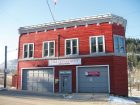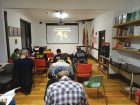
Features
Training
Trainer’s Corner: May 2015
The Greenwood Fire Department in British Columbia where I am a training officer has come through a major facelift. Department members, along with a group that shares the building, invested hundreds of hours in transforming our hall. The word “our” is important because it shows we have taken ownership. Ownership, whether it’s ownership of a building or the department as a whole, is crucial for all members in order to effect positive change.
April 20, 2015
By Ed Brouwer
The historic two-storey building that houses Greenwood’s volunteer department had become a dumping ground for the city’s unwanted furniture, sports equipment and building materials. The small meeting room had become overstuffed with a pool table, poker table, old fridges and more old sofas and chairs than a yard sale. It was dark, dingy and dirty, and looking more like a club house than a training room. In 2010 the department closed the door to that room and moved into a small room at the back of the building.
Last year I recommended we take back our room. The department needed the space (we had reached 80 per cent capacity) and I was hoping to use the positive momentum we were experiencing to raise the bar. The results are outstanding, and I am so proud of this fine group of volunteers.
We have some very skilled wood workers in our department, so the floors received a new covering of planks, sanded and varnished. The walls were primed and painted white. Bookshelves now hold our training materials. A projector was mounted into the ceiling and I scored us a 119-inch 3D ready auto projection screen. Since our restoration turned out so well, the city got on board and now the whole building is being redone.
Unfortunately, the department itself, like the old building, needed a complete overhaul. Over the past year we renovated more than just the building. Taking ownership along with encouraging each member to push for excellence has resulted in 99 per cent attendance on training nights so far this year and a 30-per-cent increase in membership.
There remains one area of concern: the election of officers. Up until recently officers were elected at the annual general meeting. A chief would say, “We need a safety officer, any volunteers?” A firefighter would reluctantly reply, “OK. If no one else is willing, I’ll try it.” Chief: “Great. All in favour?” Hands would go up and the chief would move on to the next officer position.
None of our officers had any training to help them fulfill their roles; most were uncertain about their roles. Personally, I don’t see elections working effectively, so we changed the whole process. Now when a position comes open we post the job description with the needed qualifications. After an interview, successful candidates are taken through a 13-week in-house officer’s training course. The course has little to do with fire suppression; it covers human resource management, incident management, administration and leadership.
Our executives now meet once a month for officer training. Although we are volunteers we strive to be professionals. By professional I mean having special training and skills; conducting oneself in a manner respected by members of the profession and society in general; engaging in something worthy of high standards, not necessarily for monetary gain.
Fire officers, whether full time, paid on call or pure volunteer, wear the trumpets. Look closely at your badge or your collar pins and you will see one or more speaking trumpets. These symbols come from the days when the symbol of command was a speaking trumpet. It is our symbol of professionalism.
There are five trumpets for the fire chief. In his book Making a difference, Randy Bruegman suggests that the trumpets represent the five basic roles of the fire chief: leader, manager, role model, mentor and change agent. The trumpets symbolize the traditions and lineage of our profession, and it is an honour and a privilege to wear them on our uniform.
There is a history behind the badge and a responsibility that comes with the trumpets we wear. But I fear in some ways we have failed present-day fire-service officers by not equipping them to be outstanding leaders.
If we were to dress up firefighters in the traditional PPE and SCBA and send them into a burning building without instructing them in the use of that gear, we would be liable for injuries, or worse, and perhaps charged with criminal negligence, and rightly so. But is it any less neglectful to pin sets of speaking trumpets on firefighters’ collars without giving them the skills to successfully fulfill those roles?
Officer training should not be an option. If we do not develop competency in our fire officers, we cannot expect competency from those they lead.
Simple, everyday things – such as maintaining an attitude of courtesy and respect – need to be taught at an officer level. These days we don’t relate, we transact. We tweet, retweet, Skype, post, send and hashtag . . . but few actually relate. Perhaps we are connected, but for the most part it is superficial. I can be whoever I want to be online – but when we meet in person it is the real deal. I believe that to be effective as an officer you have to actually communicate face to face with your members.
Through social media we can control how we are seen. Face-to-face conversations take place in real time. You can look into the eyes of that firefighter or officer and feel the emotion, see more of the whole picture and more effectively deal with the situation. I would take a slap on the back with a word of appreciation over a 100 Facebook likes any day of the week.
Time spent on new technology and social media sites is increasing immensely, creating less time for real-life interactions. Officers must be taught how to encourage (push forward) those on the floor; for most people, this does not come naturally.
I am privileged to have three such encouraging men in my life: Brian Morris, my old fire chief of Joe Rich Fire Department who invested 14 years of training into my role as DC training officer. Lou Wilde with Kelowna Fire Department who encouraged me to read anything and everything in print regarding firefighting tactics and survival. Both Morris and Wilde pushed me to excellence, and I am grateful. And Gene Fischer, retired deputy chief of Kelowna Fire Department, who motivated many of Kelowna area’s volunteers toward professionalism. He took an interest in us as firefighters, never treating us as only volunteers, or worse yet wannabes.
Please consider that no matter how technical we get, people are still people. And a fire officer should know to show appreciation for a job well done. You must learn how to create an environment of excellence.
People need to have challenges available to gain a sense of accomplishment. At Greenwood, we raised the bar to make it more difficult to join the department, which resulted in an increase in membership. People want to belong to an organization of which they can be proud. Bottom line: people are important. No one should need to compete for importance.
I try to motivate our officers by personally congratulating them when they do a good job. I also try to be more attentive when they are talking. It is rewarding to see those officers doing the same with other department members. Appreciation can be shown in many ways. For example, my fire chief walks me out to the truck after each practice. It is his way of saying thanks. If we in the fire service take our officers for granted we will effectively silence the speaking trumpets.
Face it; the way things are in your department is the way you allow things to be. Sure there are some things over which we have no control, and yes, we get tired of fighting for change, but I encourage you to press forward. You can either watch things happen, make things happen or wonder what happened. Let’s make things happen – let’s be game changers, proudly reflecting the high calling of our speaking trumpets.
One of the reasons I write for Fire Fighting in Canada is because the columnists really care about the fire service and continually push for excellence. The heart behind Trainer’s Corner is all about you – the training officer – so please let me know how I can serve you better. If you are old school and want to phone me rather than use that techno stuff, go for it: 250-495-4877.
Train as if lives depend on it.
Ed Brouwer is the chief instructor for Canwest Fire in Osoyoos, B.C., and training officer for Greenwood Fire and Rescue. He is also a fire warden with the B.C. Ministry of Forests, a wildland urban interface fire-suppression instructor/evaluator and an ordained disaster-response chaplain. Contact Ed at ebrouwer@canwestfire.org
Print this page

